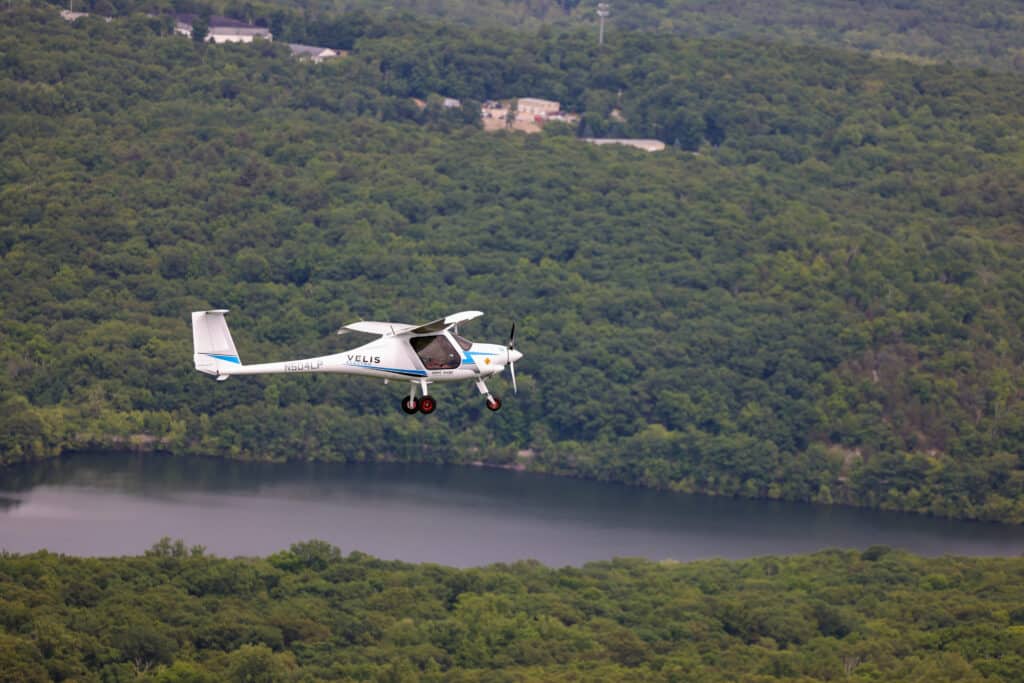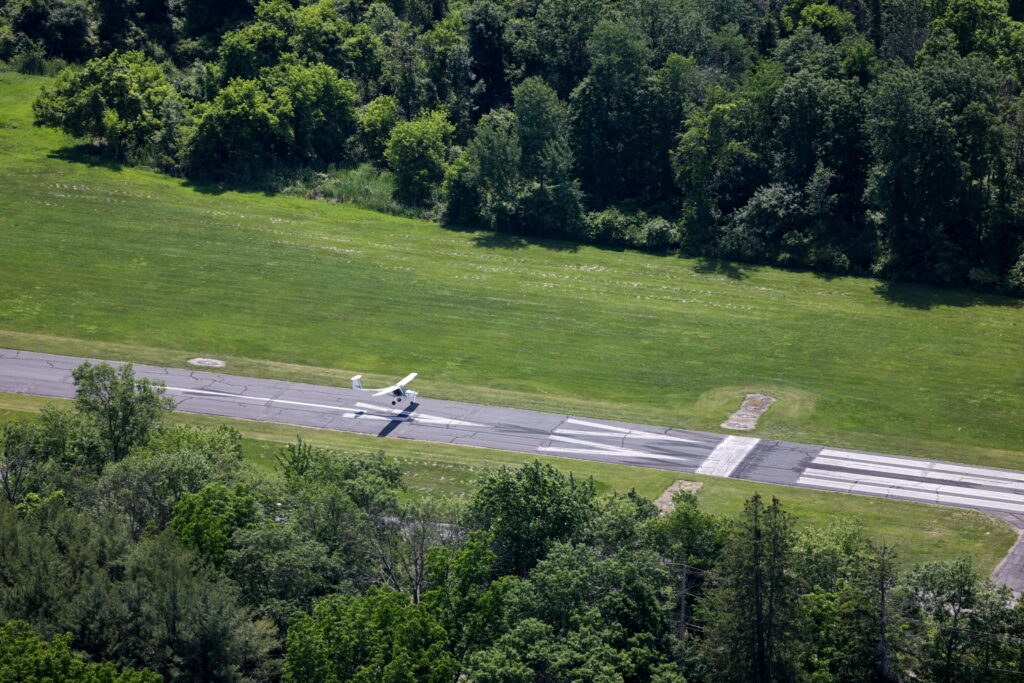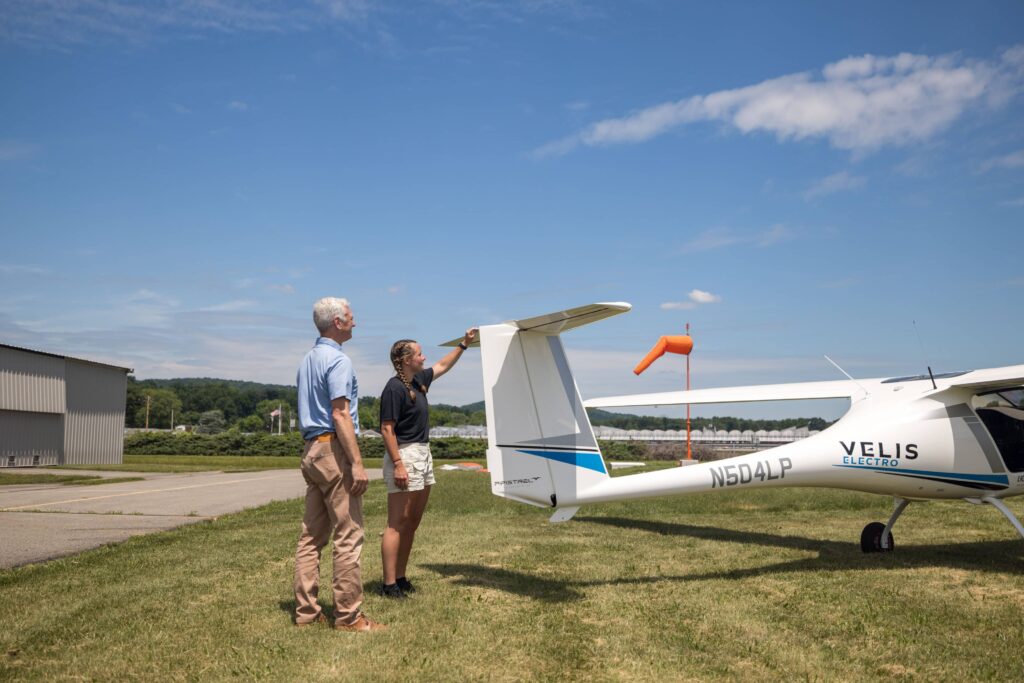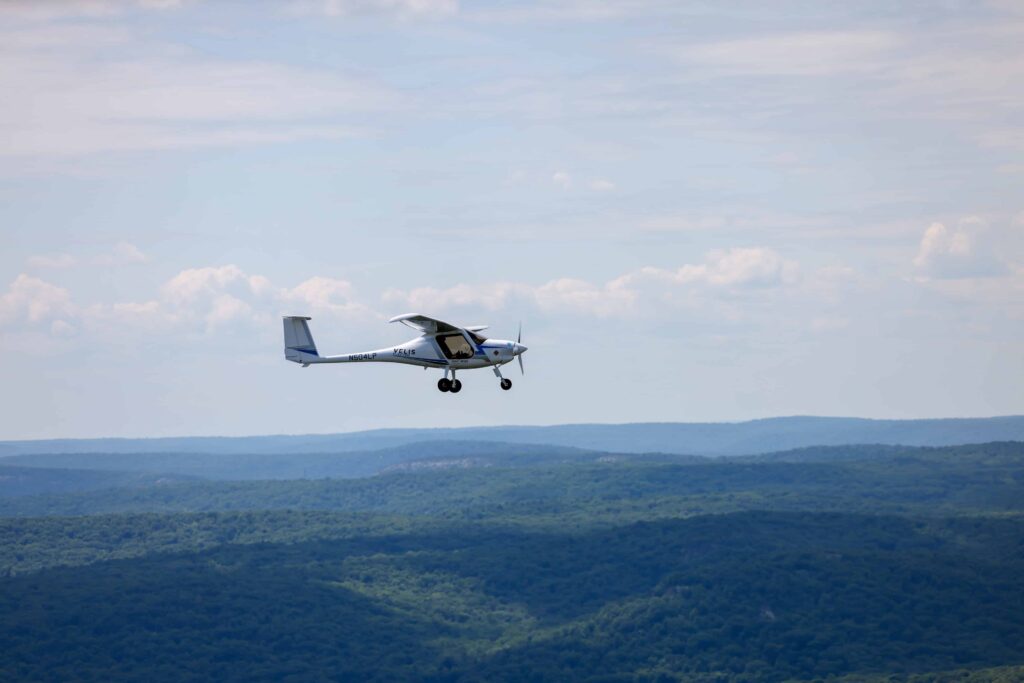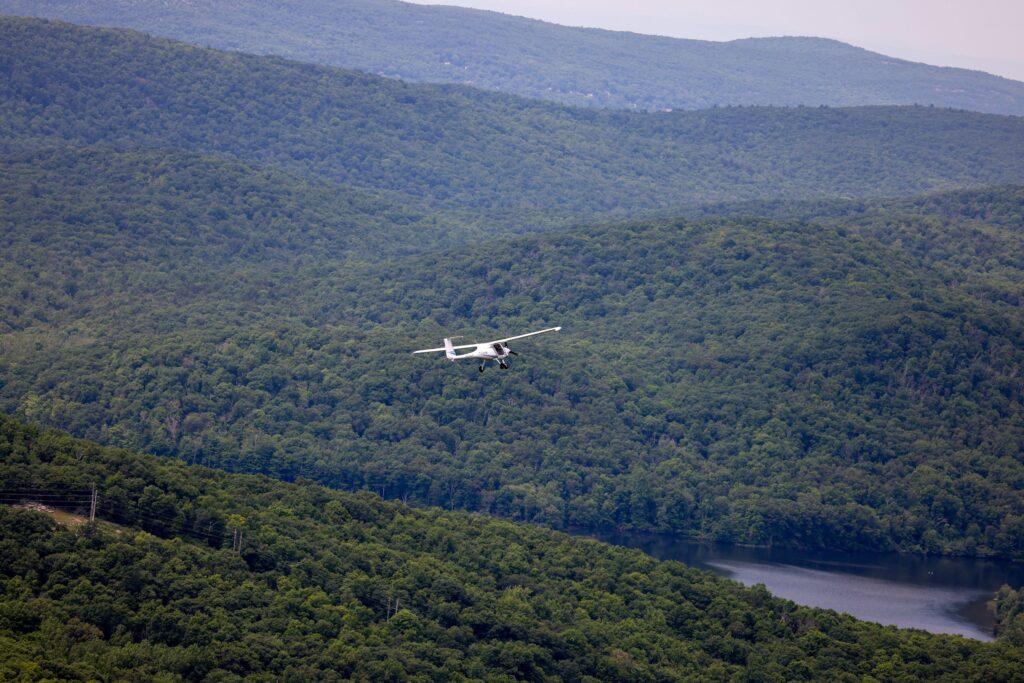Horsepower
57.6 kW MTOP
Cruise Speed
98 kcas
Max Altitude
12,000 ft
Max Range
50 mins
Useful Load
376 lb
(170 kg)
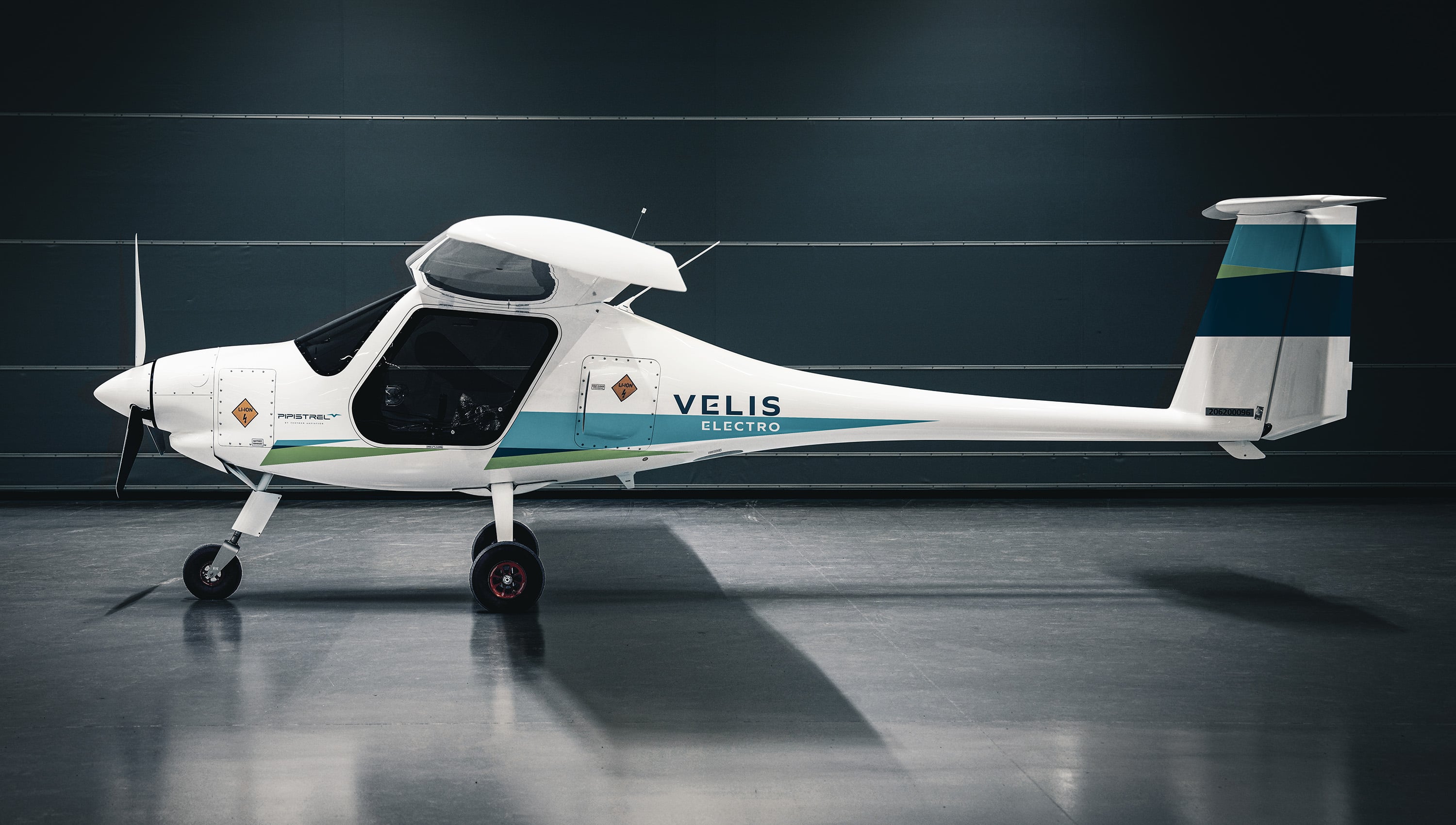
Electric is Now
Arriving from the future, the Velis Electro is the greenest way of learning to fly. Pipistrel engineers are pioneers in alternative propulsion and the company’s electric journey started in 2007 with the world’s first two-seat electric aircraft the Taurus Electro.
Today the Velis Electro is the first ever type-certified, electric-powered aircraft, fully approved for pilot training in Day VFR operations in more than 30 countries. Pilots will enjoy ease of operation with an intuitive powertrain and impressive ergonomics.
The Velis Electro is part of the Velis family of aircraft with demonstrated levels of safety built on more than 15 years of Pipistrel expertise in electric flight.
Clean and Quiet
The Velis Electro produces zero emissions during operation and with noise levels of only 60 dBa, is ultra-quiet both on the inside and outside. Both a revolution in sustainable flight and a game changer for ease of operation, the future is here and the Velis Electro has set the standard.
Innovation and Peace of Mind
The Velis Electro was designed to be simple to operate and maintain with no compromising. Power comes from Pipistrel’s own type-certified electric engine, the E-811, producing 57.6 kW from a 345 VDC electric system and in-house developed dual battery system. This revolutionary powertrain is entirely liquid cooled, can be charged through the on-board charging port with an external charger and has demonstrated high levels of safety.
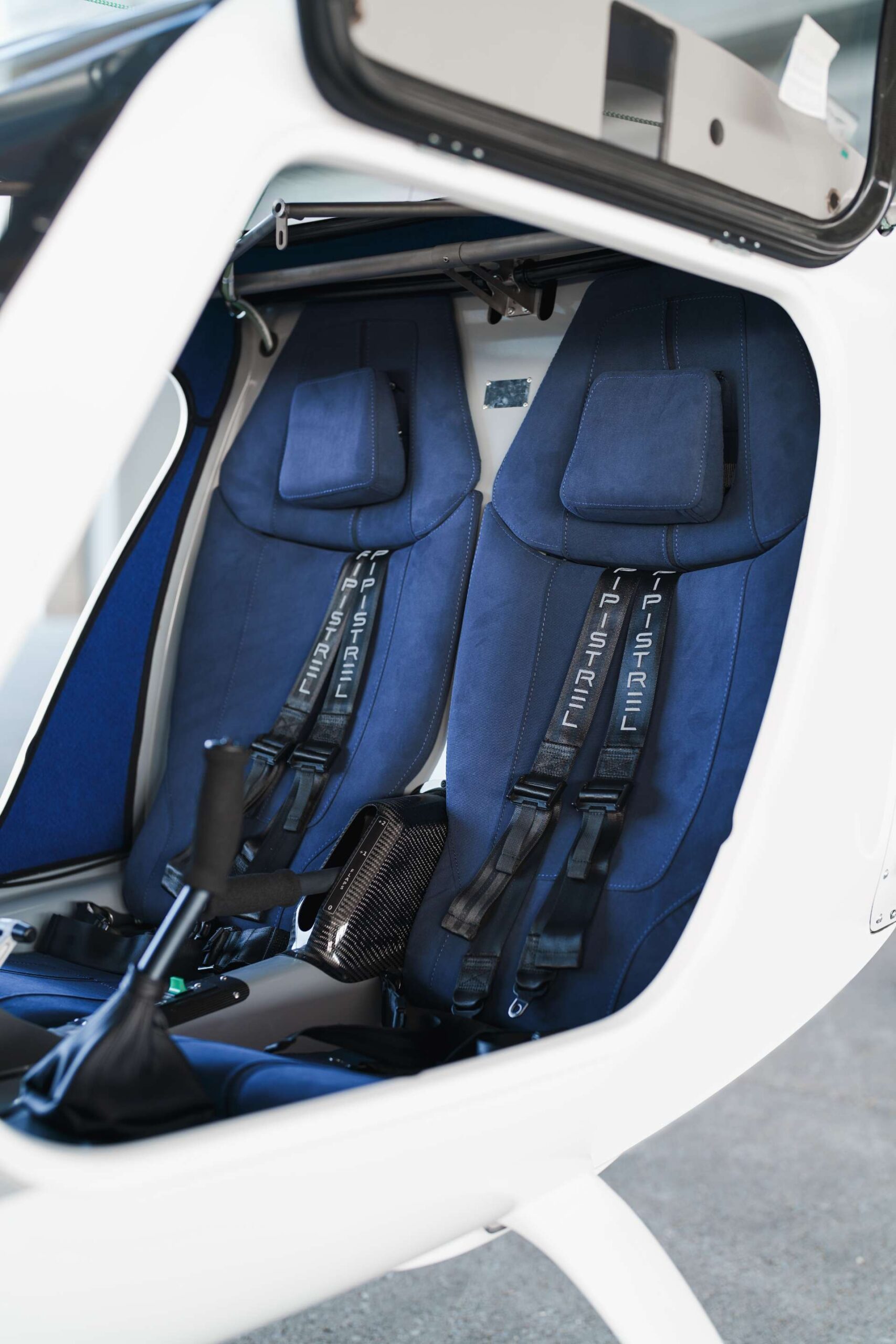
why velis electro?
Efficiency as Standard
- Revolutionary, game changing ease of operation and the most sustainable way to fly producing zero emissions during flight.
- Quiet on the inside and outside. At just 60 dBa the Velis Electro is noise friendly bringing flight closer to noise-sensitive urban areas.
- Low cost of operation with no fuel costs and low maintenance costs. The Velis Electro is both environmentally friendly and cost effective.
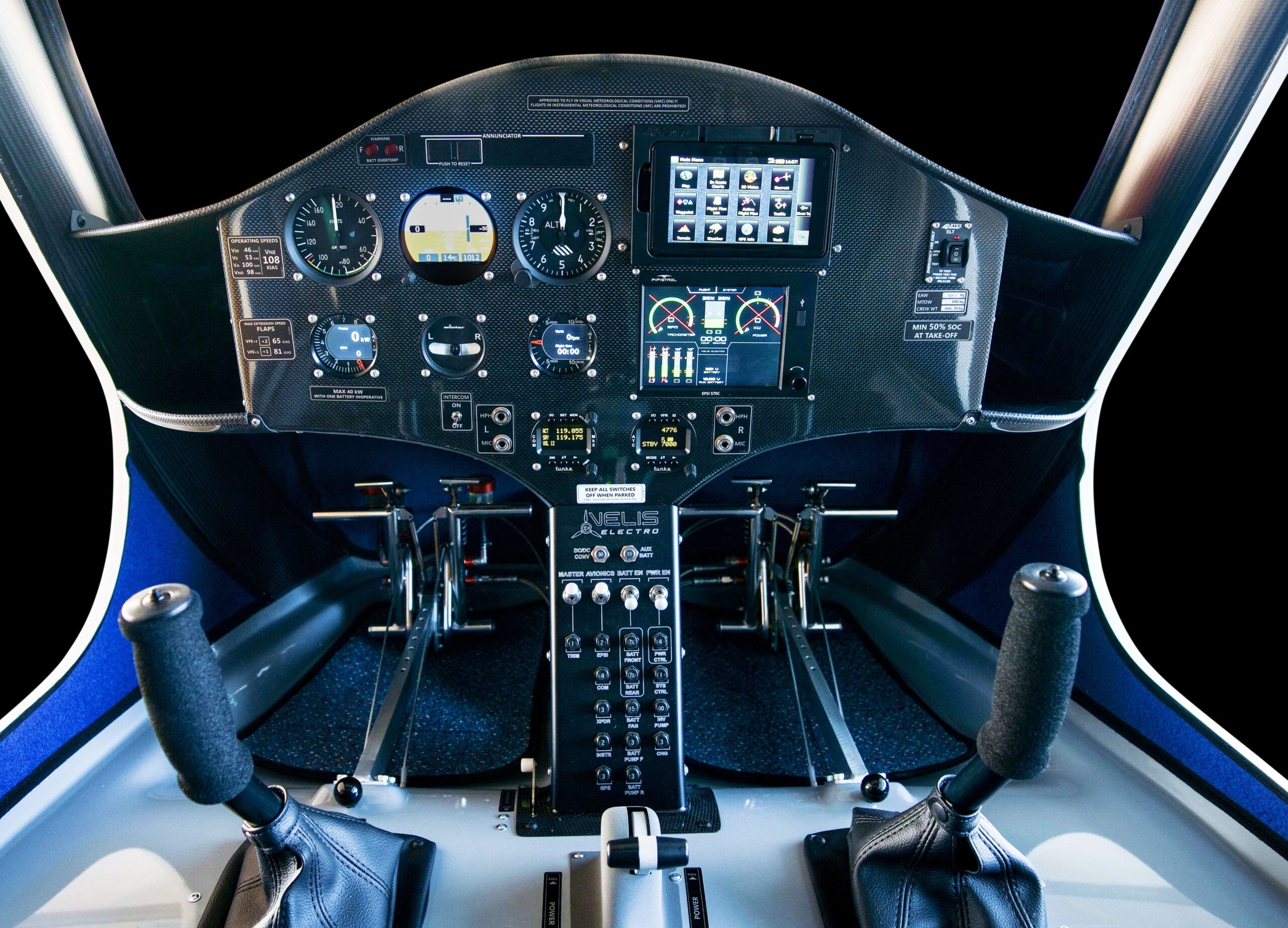
Technical Data Pipistrel Velis Electro
VELIS ELECTRO: Arriving from the future, EASA type-certified now
Najbolj zelen način učenja letenja!
Velis Electro is world’s first electric powered airplane to receive a Type Certificate (EASA.A.573 TCDS). The two-seater, intended primarily for pilot training, is a game-changing aircraft in terms of technological innovations and cost-efficiency. Velis Electro can be operated commercially and is fully approved for pilot training as well as other operations. With its quietness, Velis Electro can bring flight training much closer to urban areas without adversely affecting communities’ quality of life.
Čist in umirjen
Velis Electro je s svojo ravnjo hrupa le 60 dBa bistveno tišji od drugih letal in sploh ne proizvaja izpušnih plinov. Njegov revolucionarni pogonski sklop je v celoti tekočinsko hlajen, vključno z baterijami, in je pokazal odpornost na napake, toplotne pobege baterije in udarne obremenitve kot del postopka certificiranja. Velis Electro lahko deluje v mrazu, vročini in dežju.
Velis Electro, ki je bil zasnovan kot temeljni član sistema za usposabljanje Velis, je bil zasnovan tako, da je preprost za delovanje in vzdrževanje, a zato nič manj varen. Z uporabo Pipistrelovega certificiranega električnega motorja Velis Electro zagotovi moč takoj in brez odloga. Z uporabo poenostavljenega uporabniškega vmesnika v pilotski kabini pa ohranja enak videz in občutek svojih konvencionalno napajanih letečih sorodnikov. Zmanjšano število gibljivih delov dramatično znižuje stroške vzdrževanja, tveganje za okvare pa se zaradi vgrajenega sistema, ki neprestano nadzoruje stanje, še dodatno zmanjša. Ta izboljšana zanesljivost omogoča Velisu Electro, da ima več kot dvojno življenjsko dobo elementov pogonskega sklopa v primerjavi s prejšnjo generacijo električnih letal.
Varnost
As part of the Type Certification, Pipistrel demonstrated that Velis Electro achieves the highest levels of safety, even surpassing those required for conventionally powered aircraft.
Velis Electro is a full-electric derivative of the proven Virus SW 121, which is already type certified by the European Union Aviation Safety Agency (TC No EASA.A.573). It is equipped with a Pipistrel type certified electric engine E-811-268MVLC (TC No. EASA.E.234), developed with partners EMRAX and EMSISO, and Pipistrel’s three-bladed composite fixed pitch propeller P-812-164-F3A. The 57.6kW liquid cooled electric engine provides power to the aircraft.
The power is delivered by 345 VDC electric system built around a liquid-cooled in-house developed high performance battery system, which includes two Pipistrel PB345V119E-L batteries connected in parallel, installed in a redundant 2-unit arrangement, total nominal capacity 20 kWh. Crashworthy, thermal runaway inhibiting, HIRF/EMI tolerant.
En akumulator se nahaja v nosu letala, drugi pa za kabino. To zagotavlja presežnost vira energije: v primeru okvare akumulatorja, bi se baterija v okvari samodejno izključila iz sistema. Že en sam akumulator je sposoben samostojnega delovanja in ima dovolj moči, da omogoča vzpenjanje in nadaljevanje leta.
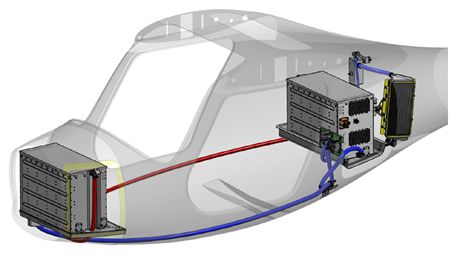
Sistem za tekočinsko hlajenje je sestavljen iz hladilnika in dveh zaporedno nameščenih električnih črpalk, ki se nahajata za zadnjim akumulatorjem. Dovod zraka za hladilnih se nahaja na levi strani trupa, topel zrak pa odvaja na dnu. Za hladilnikom sta nameščena dva aksialna ventilatorja velike moči, ki omogočata hlajenje baterije med polnjenjem. BMS nadzorni sistem samodejno nadzoruje in usklajuje za nemoteno delovanje.
Baterije je mogoče polniti preko vgrajenega polnilnega priključka z električnim polnilnikom Pipistrel. Celoten proces nadzira glavni računalnik, ki prikazuje stanje vseh sistemov na Pipistrel EPSI 570C.
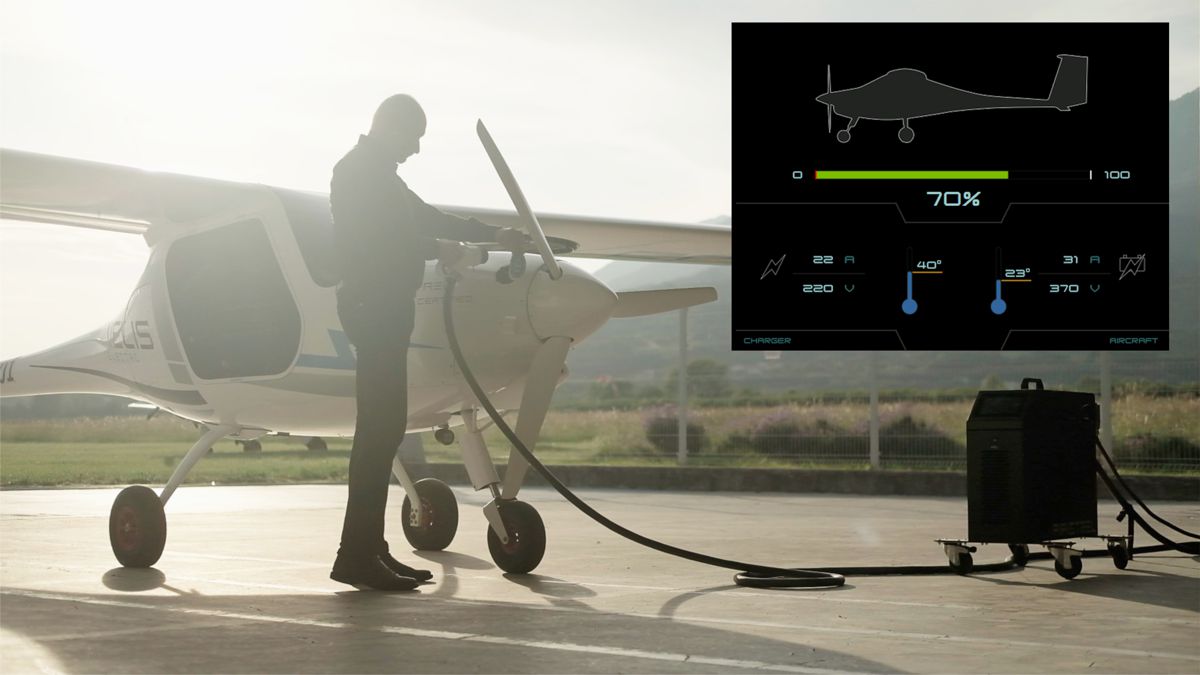
5,7-palčni LCD EPSI 570C zaslon v kabini je glavni vir informacij za pilota o operativnem stanju električnega pogonskega sistema v letalu, z intuitivno grafiko za prikaz vseh ustreznih parametrov.
EPSI 570C se uporablja tudi kot portal za posodobitve sistemske programske opreme.
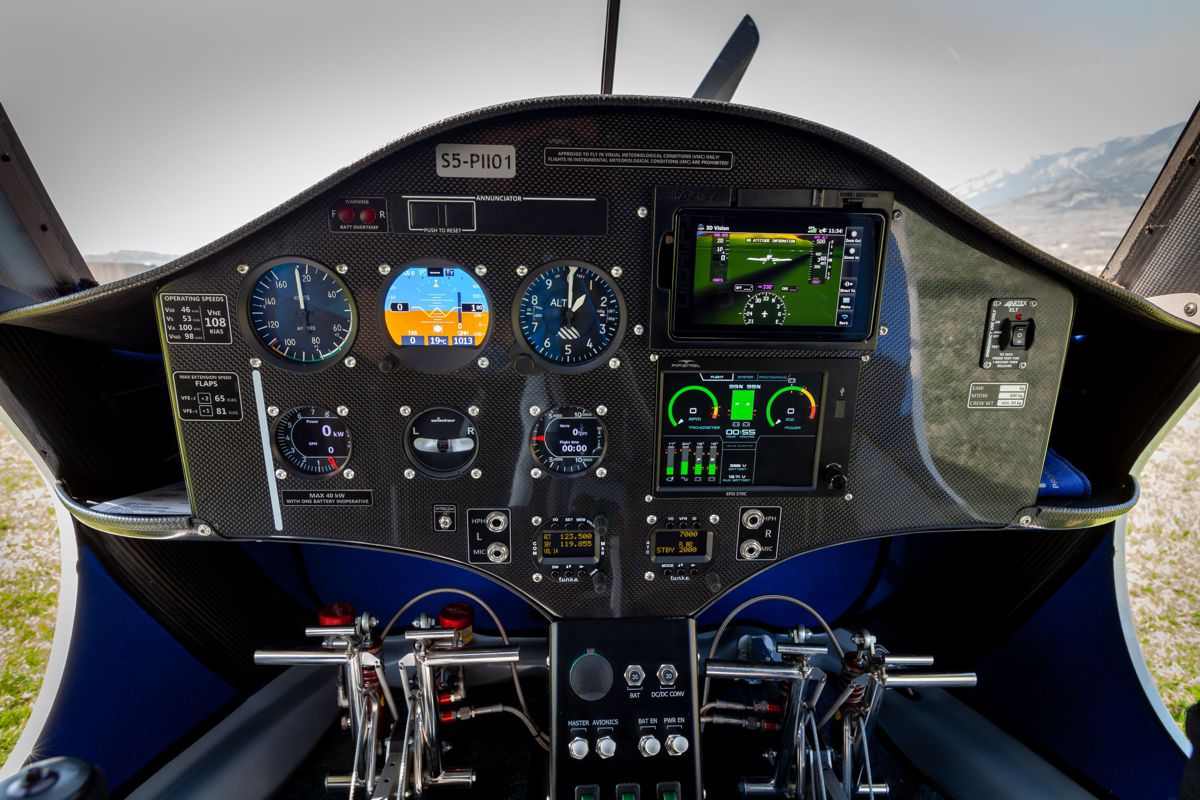
Za razliko od postopka zagona letala s konvencionalnim pogonom se Velis Electro prižge s štirimi stikali in ne potrebuje časa za ogrevanje pred vzletom. Ta sprememba paradigme skupaj z neprimerljivo tišino tako znotraj letalske kabine kot tudi zunaj pomenijo, da je Velis Electro resnično prelomno letalo, ki bo revolucionariziralo vašo organizacijo in omogočilo novo generacijo pilotov.
Technical Data Pipistrel Velis Electro
Note: Data is for ISA sea-level conditions. Pipistrel reserves the right to revise this data sheet whenever occasioned by product improvement, government/authority regulations or other good cause.
FREQUENTLY ASKED QUESTIONS
General
Velis comes from the ablative case of the Latin word for “sail” (velum, veli) and translates into “moving with sails (unaided)”. Its name reminds you of sailing boats, which, quiet and green, have cruised the seas of the world for centuries. Velis Electro is then the forerunner shaping a new era of aviation.
- Velis Electro ima v celoti tekočinsko-hlajen pogonski sklop, vključno z baterijami, ki so prav tako tehnologija naslednje generacije. Zahvaljujoč tem izboljšavam je življenjska doba pogonskega sklopa dvakrat tolikšnja kot pri prejšnji generaciji električnih letal. Motor in krmilnik moči sta izboljšana tudi za robustno delovanje v vročih in hladnih podnebjih.
- The Velis Electro has a 50 kg higher MTOW than the Alpha Electro.
- In the cockpit, the Velis Electro includes an embedded data-logger, and a tactile and aural AOA-based stall warning.
- The aircraft has heavy-duty landing gear and wheel brakes, 15% more energy onboard and its systems have shown resistance to HIRF (direct and indirect effects).
- And finally, the Velis Electro is EASA type certified, which opens the door for commercial operation.
For pricing and additional options please contact sales@pipistrel-aircraft.com
Type Certification
By issuing a Type Certificate, EASA confirms that the aircraft, intended for serial production, is in compliance with applicable airworthiness requirements established by the European Union air law. It allows the aircraft to be exploited commercially.
Previous electric aircraft have obtained different levels of approvals from national authorities, however, none has been able to demonstrate levels of safety equivalent to standard category aeroplanes or was able to operate commercially.
We are working to validate the TC for the Velis Electro in other countries as we did with the Virus SW 121. We are also working to create certification paths with the FAA, but at this moment it’s difficult to predict when it will happen. Of course, we will announce it on our website, so please follow our online releases.
Pipistrel has other aircraft from the Velis Training System designed for intentional spin and UPRT training.
Battery and Charging
In the scope of the certification process, the batteries went through an extensive series of tests that thoroughly evaluated the integrity of the battery packs and their ability to resist thermal runaway. Special safety features are built into the design to achieve levels of safety according to the stringent DO-311A requirements. The batteries have demonstrated to be crashworthy, resistant to thermal runaway and fault-tolerant.
The charging logic was tuned in a compromise between charging time, ambient temperature robustness and battery system lifetime. A normal charging cycle from 35% to 95% SOC (state-of-charge) takes up to 1 hour and 20 minutes. A full charge from 30% to 100%, depending on ambient temperatures and age of battery takes up to 2 hours. Operational experience and technical improvements will allow us to activate charging logic profiles for shorter charging times.
To maintain superior longevity of the battery, a breakthrough design employing liquid cooling for the batteries was employed, which precludes quick battery swapping. Consider that each of the two batteries weighs approximately 70 kg; quick swapping would necessitate additional ground handling equipment and introduce potential safety hazard associated with battery dropping on the floor. Pipistrel recommends using more Velis Electro aircraft in your fleet to enable quick turn-around times for students and instructors when using the superior SkyCharge line of Pipistrel in-house developed aircraft battery chargers.
While a single-phase 240 VAC regular wall socket can be used for overnight charges, Pipistrel recommends a three-phase 380 VAC connection, in order to enable quick charging.
The Velis Electro has a DC GB/T 20234 connector. Even if this standard connector is also used on cars, Velis Electro charging is allowed only with a Pipistrel portable charger or a Pipistrel Sky ChargeTM charger. Charging electric aircraft has its specifics which not only require addressing the technical feasibility of electrical power transfer but also matters related to cybersecurity and enhanced levels of safety when compared to automotive-class charging. Pipistrel has recently announced a partnership with GreenMotion, a leader in the vehicle charging industry, to work towards enabling dual-use chargers.
Performance
The endurance was designed to cover for typical flight school utilisation for local flying (50 minutes plus reserve) and is a compromise between performance, environmental robustness (flying in hot, flying in cold, charging in hot, charging in cold) and battery system lifetime.
The Velis Electro is designed for local flights to work alongside other aircraft of the Velis Training System, therefore A to B flights are not part of the typical mission. Endurance for training sorties is, therefore, the appropriate parameter to quote.
The TBO (time between overhaul) of the motor is 2000 hours. The initial limitation imposed on the batteries is 500 hours. Pipistrel expects to increase the TBO of the batteries as additional testing and operational experience is accumulated.
Environment
Featuring noise levels of only 60 dBa, the Velis Electro is significantly quieter than other aeroplanes both inside and on the outside. This, together with the fact that it produces no combustion gases at all, makes it one of the least polluting aeroplanes.
Absolutely. Even if the batteries endurance is affected by cold weather, the engine performance is not altered.
The Velis Electro is intended for VFR-day operation and has been tested flying in the rain. The rain itself does not present a hazard to the electrical powerplant.
The charger requires a connection to a single-phase or, ideally, to a three-phase wall socket. Whether the electrical power comes straight from the grid or from other sources (solar, wall-mounted batteries, wind, etc), this does not depend on Pipistrel and should be consulted with the local electrical service provider.
Pilots and Maintenance
5,7-palčni LCD EPSI 570C zaslon v kabini je glavni vir informacij za pilota o operativnem stanju električnega pogonskega sistema v letalu, z intuitivno grafiko za prikaz vseh ustreznih parametrov. Izboljšano situacijsko ozaveščenost zagotavljata sistem za opozarjanje posadke (CAS) in nadzorna plošča.
Velis Electro can be operated by LAPL or PPL holders and instructors following a quick difference training course.
The Velis Electro is ideal to train student pilots towards their LAPL and PPL licences. It is optimized for local flights around the aerodrome, i.e. take-off and landing sorties. The EASA exemption for pilot licencing and training permits the Velis Electro to be utilised in flight training environments and assuring transitions of pilots to and from Velis Electro even before they have obtained a pilot licence.
The Velis Electro is simple to maintain. The powertrain has a much lower number of moving parts and the time between overhaul/replacement of the motor is much longer than that of a piston engine. Batteries are replaceable as an LRU (Line Replaceable Unit), without special skills required related to high voltage or electric powertrains. EASA’s exemption, which was coordinated between French, Swiss, Slovenian CAA’s and Pipistrel, sets forth requirements for Part-66 licenced mechanics, which include a difference training course specific to Velis Electro. Battery overhauls will be initially handled by Pipistrel alone.
Annual inspection for ARC (Airworthiness Review Certificate) renewal can be performed by any National Aviation Authority (NAA) or Part-145 organisation with this privilege, with a Part-66 mechanic that has received the type-specific training at Pipistrel.
About Pipistrel and Other Questions
It is a line of products forming an integrated flight training solution, conceived especially for flight schools, included but not limited to Pipistrel Academy, VR Simulators and several aircraft options optimised for pilot training. More details on this will be unveiled soon.
In chronological order: Taurus Electro, Taurus G4, Taurus Electro G2, WATTsUP, Alpha Electro, HY4, Panthera Hybrid, Velis Electro, Alpha Electro LC.
It is a new approach in the aerial mobility market that will be enabled by advanced propulsion technologies such as hydrogen fuel cells, electricity, etc. A microfeeder is a zero-emission commuter-class aeroplane, capable of connecting smaller airports close to communities with larger hubs, whereas a miniliner connects smaller airports between themselves, without compromising the quality of life due to low noise and zero-emission operation, but dramatically shortening travel times inside the European Union. Pipistrel is collaborating with renowned European universities in the development of a disruptive 19‑seater. We will provide more details of this in the future. More information about this project is available here.
Poznavanje letalskih priročnikov naredi vaše letenje veliko varnejše in učinkovitejše. Objave na strani Pipistrel Technical Publication Portal so vaša osrednja lokacija, kjer lahko najdete vse priročnike in informacije o storitvah na enem samem mestu.
Iščite po vsebini, največji vzletni teži, kategoriji ali imenu modela. Funkcijo iskanja najdete tudi v zgornjem desnem kotu portala tehničnih publikacij.
To attain the access username and password for the Technical Publications Portal, please contact our customer support at sales@pipistrel-aircraft.com
